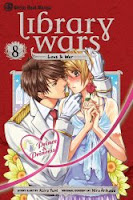 Creator: Saiko Takaki
Creator: Saiko Takaki
Original story: Hideyuki Kikuchi
U.S. publisher: Digital Manga
ISBN: 9781569708279
Released: November 2007
My introduction to the works of Hideyuki Kikuchi was through Vampire Hunter D, Volume 1, Saiko Takaki’s manga adaptation of Kikuchi’s light novel of the same name. I first read Vampire Hunter D, Volume 1 after borrowing it from my local library; later, Digital Manga would send me a copy as part of a Kikuchi care package. It seemed appropriate to give Vampire Hunter D, Volume 1 another, closer look for the October 2012 Manga Moveable Feast which focused on vampire manga. The Vampire Hunter D manga adaptation is an interesting project. Coordinated by Digital Manga with Kikuchi’s direct involvement, the goal is for each volume of the original Vampire Hunter D series of novels to be adapted. (So far, six of the more than twenty novels have received the treatment.) Takaki was personally selected by Kikuchi to work on the project and is responsible for illustrating and adapting the novels as manga. Vampire Hunter D, Volume 1 was simultaneously released worldwide in 2007.
After nearly annihilating themselves in a nuclear holocaust, the remnants of human society now struggle to survive in a world filled with mutants and monsters, the most powerful of which is a race of vampires known as the Nobility. But even the Nobility’s reign of terror can’t last forever; thousands of years later the vampires themselves are now also in decline. Even though their control over the world is slipping away, the Nobility are still extremely dangerous and are a threat to what is left of humankind. Doris Lang, a beautiful young woman from the frontier town of Ransylva, has been bitten by one of the Nobility, putting her life at great risk. To save herself, she hires a vampire hunter known only as “D.” Although appearing as a young man, D is a dhampir—the son of a human mother and one of the Nobility. Reviled by both vampires and humans, D is in an unusual position. His heritage grants him superhuman skills and power, making him an ideal vampire hunter and nearly as dangerous as the Nobility.
Takaki’s artwork in Vampire Hunter D is well-suited for the story. It’s darkly beautiful, striking, and yet disconcerting. (Although, perhaps, not always as horrifying as I might hope.) At times the art is vaguely reminiscent of the work of Yoshitaka Amano, the illustrator for the Vampire Hunter D novels. Great care has been taken with the character designs, especially D’s. He is the epitome of tall, dark, and handsome—easily the prettiest character in the manga. I particularly liked the attention given to the details of his attire. A brooding anti-hero who rarely smiles, the more terrifying side of D’s dhampir nature is rarely seen. It’s easy to forget how dangerous he really is as he plays the part of the “good guy” well. But occasionally there is a glimpse of fangs and malice as he struggles to control his desires.
While I wasn’t overly impressed by Vampire Hunter D, Volume 1 when I read it for the first time, the manga has grown on me after subsequent readings. Since I haven’t yet read the original Vampire Hunter D novel, I can’t comment on how the manga compares or even how it works as an adaptation. However, I do think it is fairly successful as its own work. The story is quickly paced but there are leaps and potential inconsistencies in the plot that require readers to fill in what happened themselves. (This is actually something I’ve seen in other works by Kikuchi, so it wouldn’t surprise me if this issue comes directly from the source material.) Still, there is plenty that I like about Vampire Hunter D, Volume 1: it’s post-apocalyptic setting, D himself, the mix of traditional vampire lore and advanced technology, the interesting powers granted to the mutants. In the end, I do want to read more of the Vampire Hunter D manga and maybe even give the original novels a try.
Thank you to Digital Manga for providing a copy of Vampire Hunter D, Volume 1 for review.










